News & Articles
Minneapolis Ice Dam Prevention
May 27th, 2016
by Aaron Fruit
Using Insulation and Roofing to Address Chronic Ice Dam Issues in Minnesota
How to Prevent Ice Dams In Minnesota
Ice dam prevention in Minnesota is a tricky business. So much so that we hesitate to say any home is truly ice dam proof. It’s true that homes built after roof trusses became popular are far less likely to have ice dams than stick frame homes. There is simply more room in the roof system for insulation and ventilation, the two primary considerations when exploring ice dam issues on the standard home. A project we do quite frequently is shown in the photo below. We remove the roofing from the affected roof pitch, remove the roof decking, add high-performance spray foam urethane insulation and then re-roof using ice and water membrane to exceed Minnesota building code.
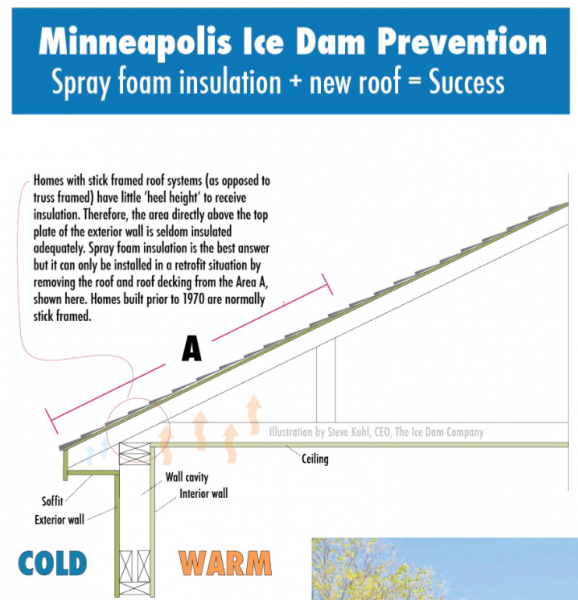
Posted in Uncategorized
Who to Call With a Roof in Limbo?
May 18th, 2016
by Aaron Fruit
Repair or Replace Your Roof…Start First with an Honest Roofing Contractor
The Problem:
At some point in the life of your roof, regardless what type it is, there will be a time when fixing a few problematic spots will stretch out its remaining life by a few years. You can call a standard roofer, but chances are you will soon be having a conversation about replacing the whole roof. Or, you can call the guys you had wash it a year or two ago, but they are not qualified to do the professional roof repair you need if it involves something beyond installing a few shakes.
The Solution:
Hire Kuhl. The fire in our bellies isn’t based on replacing roofs or washing roofs. It’s based on doing what is best for you and your home.
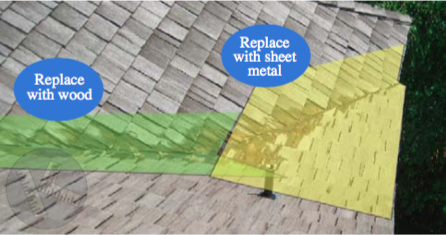
We used old-school hand-soldering to join these copper sheets together at the lowest section (pan). This project would typically be too small for a roofer to care about and too sophisticated for mere roof washers to understand.
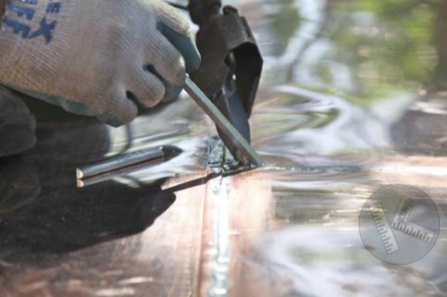
This is a 16 year old medium hand-split cedar shake roof. Aside from the rotten valley, it has about another 8 years of life left in it. We saturated the entire roof with our commercial wood preservative after replacing the valley with hand-soldered copper.
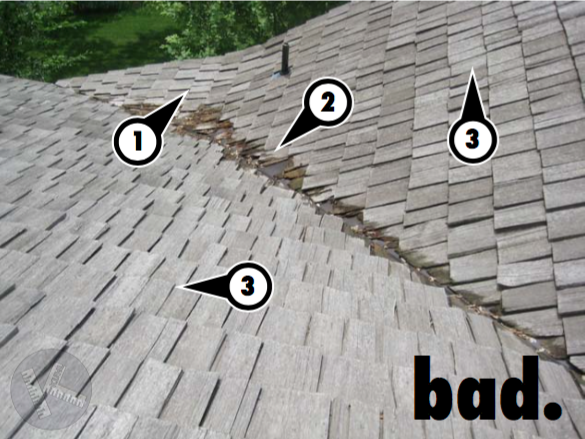
- Low slope area was leaking off and on for a couple of years.
- Organic material settled in valley, creating severe rot.
- These areas have many more years or service left in them.
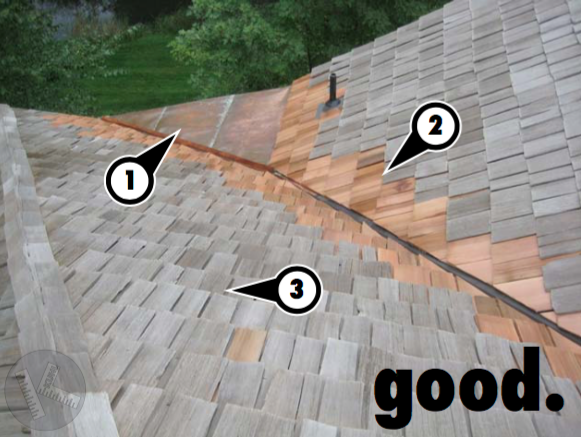
- New bomb-proof copper pan. Take that, water!
- New feathered, close valley.
- The remaining roof areas needed virtually no repairs.
Posted in Uncategorized
Why Orange You Going to Stain Your Roof?
May 12th, 2016
by Aaron Fruit
Staining Your Cedar Shake Roof is Not a Great Idea…Here is Why
The Problem:
Your neighbor just had some stuff sprayed on his roof and it looks pretty spiffy. It looks almost like a new roof! But here is the problem with pigmented products when applied to cedar shakes: they fade in irregular patterns after one to two years. That’s why your neighbor is going to be pissed in about three years. It is possible to have your roof stained orange and have it be successful and long-lasting. We have done it. All else held equal, we advise our clients to steer clear of colored roof products. Here are five examples from local homes where the orange roof didn’t work out well. Done by others, of course.
The Solution:
Don’t stain your roof orange.
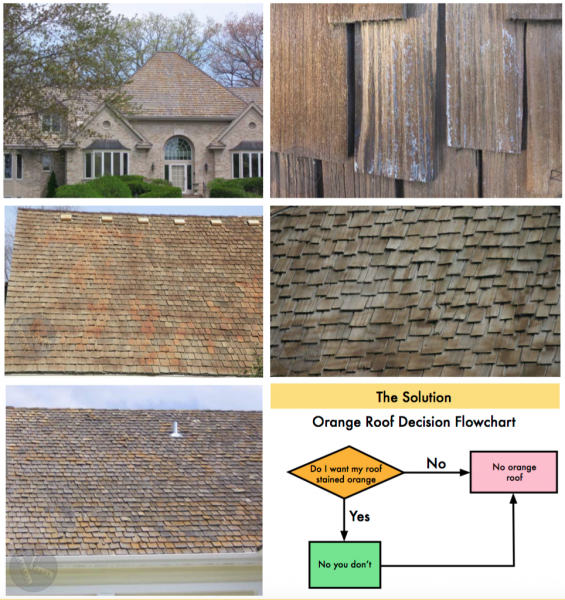
Posted in Uncategorized
Minneapolis Hail Damage Map
August 22nd, 2015
by Aaron Fruit
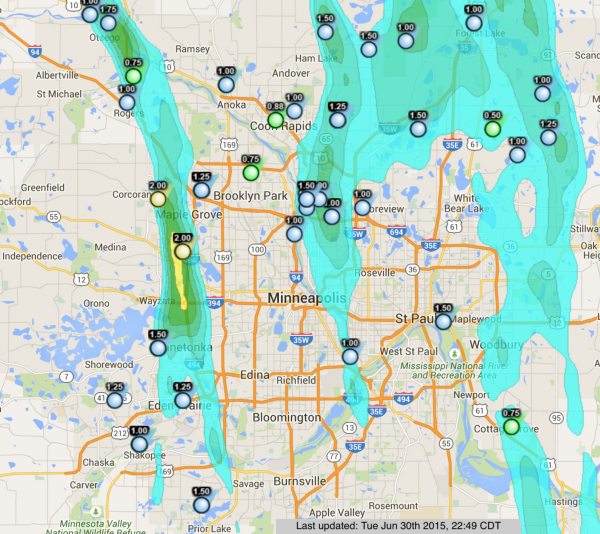
Minneapolis storm damage repair company
Minneapolis area home owners are often surprised at how quickly storm chasers arrive at their door steps after the storm itself has subsided. It’s a safe assumption that strangers will be knocking at your door within an hour after a hail storm passes through your neighborhood. We have to admire the efficiency with which these companies operate. That said, it’s not a game we play. We pride ourselves in the fact that the majority of our business is won organically, the old fashioned way. We do great work and make people happy enough to tell their friends and neighbors about us. It’s a great system.
We do a fair share of repair and replacement work in Minneapolis to fix the damage left behind by both storms and storm chasers. We have many cases under our belts where the unsuspecting homeowner hired a door-knocker with bad results. Normally, their crappy workmanship doesn’t manifest for a couple of years, at which time they are long gone, either out of business or out of Minnesota altogether. Back in the office we continue to be amazed at how dumb, yes dumb, homeowners are who trust people who knock on the door. The first clue that a company doesn’t have enough work through reputation alone is that they have to send guys out before the storm clouds have left.
Is it possible to get a high quality job done by door knockers? Yes. Is your probability of having trouble with that company higher than if you chose a company with a deeply established history of excellence in your community? Absolutely. The question becomes, why on earth would you take the risk? Why trust what is probably the most valuable asset in your life to people that randomly knock on your door? We are often amazed at how many otherwise intelligent homeowners throw caution and common sense to the wind and hire a guy who knocked on the door.
A very common approach to success in storm chasing relates to yard signs. Believe it our not, there is an entire strategy surrounding yard signs. Storm chasers will smooth talk their way into allowing the placement of a single yard sign in a neighborhood and then refer to that ‘job’ as evidence of their credibility. “We are working for Mrs. Johnson. You may have seen our sign…”. It’s not uncommon to see a company with many yard signs in a neighborhood. Common sense would suggest that yard signs mean jobs are happening. In fact, a yard sign only indicates that a homeowner has agreed to let said storm chaser discuss the hail damage with their insurance company. That’s it. In many cases those conversations are fruitless, resulting in no hail damage coverage. By law of averages, some jobs do occur. In either case, it always makes sense to do your research and hire the very best company you can when it comes down to discussing your storm damage claim with your insurance company. We are that company.
Here is a standard hail damage map of the Minneapolis area. These maps are cranked out within minutes of a significant hail event and provide a battle plan for the legions of door knockers and storm chasers. With such maps, storm chasers are able to target specific neighborhoods quite efficiently.
Minneapolis Storm Damage Map
Posted in Uncategorized
Cooling Tower Ice Removal – Minneapolis
March 11th, 2015
by Aaron Fruit
Ice dam removal in the Twin Cities has been all but non-existent this season. That’s good news for most homeowners! Ice removal on the commercial side of the universe seems to be a more consistent problem year to year and this season was no exception. The calls we typically get involve removing ice from around cooling towers or cooling units on roofs. These projects offer some interesting challenges including the fact that the work area is usually high and far away from the nearest parking. Our sister company, The Ice Dam Company, uses steamers to remove ice from around industrial cooling towers. Their machines have hundreds of feet of hose and yet even that is not enough for some jobs. The answer is to use a crane to get the steaming equipment up onto the roof of the building. Other challenges in ice removal from around industrial equipment include the fact that there are usually 440 volt power feeds and natural gas lines embedded in the ice. Steam is a great way to remove ice from around industrial equipment for the reason that it is gentle and quick.
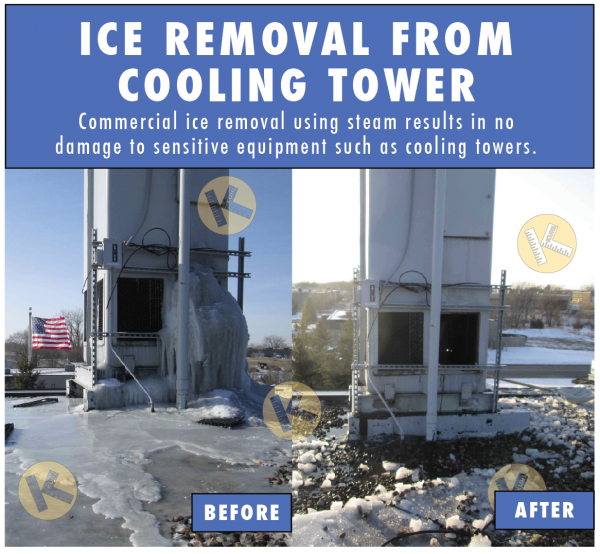
Ice removed from cooling tower
Posted in Uncategorized
What causes ice dams: Answer #93
January 13th, 2015
by Aaron Fruit
What causes ice dams? Google that question and you will get a lot of answers, the most common of which will be something about heat escaping into the attic, which in turn causes snow to melt on the roof and refreeze on a lower area. Standard stuff. In a broader sense, ice dams are caused by a differential in roof temperatures where a higher area is above 32 degrees (snow melts there) and a lower area where temps are below 32 degrees (melt water reverts to ice there). It’s true that in the vast majority of the cases we study the cause of the ice dams is indeed escaping heat as the result of air leaks and inadequate/improper insulation. But we have also been involved in cases where the roof system is insulated perfectly and yet ice dams still occur. The diagram below describes one situation that can cause ice dams that has nothing to do with insulation, air leaks or ventilation issues. Put simply, the sun can melt snow that then runs down to a cold area on the roof where it refreezes into ice, forming an ice dam. It’s not nearly as common as the aforementioned causes but it does happen. For example, check out the diagram below:

Sun causing ice dams, does sun cause ice dams?
Wind is another factor often overlooked in the creation of ice dams. See the diagram below. Wind can have dramatic affects on the snow load on a roof and under certain conditions, a difference in snow thickness can contribute to the formation of ice dams.
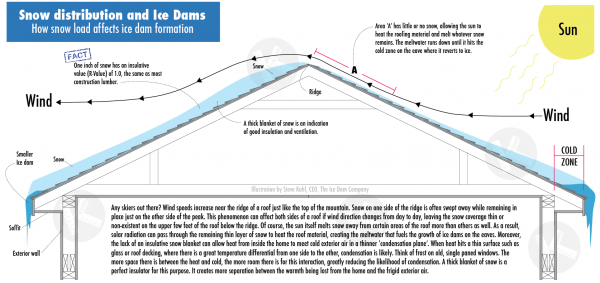
Roof snow and ice dams the relationship between
Posted in Uncategorized
How to deal with water leaking into your home
January 12th, 2015
by Aaron Fruit
I’ve been asked many times over the years about how to deal with water leaking into a home. It’s obviously a super stressful situation, so having a few pointers can help. Here is a PDF that shows one technique for managing water leaks into your home (Ice Dam Leaks Minneapoils Water leaking down walls Minnesota 1-12-15). The bottom line is that you need to think creatively. There are very few wrong answers when it comes to dealing with water leaking in through your roof. One ‘wrong answer’ I’ve seen is to ignore the problem. Don’t simply allow the water to do what it will. Collect it and pour it down the drain. It belongs in the Mississippi River, not your floors, walls and ceilings. Another common mistake I have seen Minneapolis homeowners do with water leaks is to lay down towels on their hardwood floors and allow the water to soak in and sit for extended periods of time. Don’t do this. Wood floors don’t like moisture. A soaked towel creates a perfect place for water to work against the dimensional stability of your wood floors. In other words, you will greatly increase the likelihood of warping and damage if you allow water to hang around in a wet towel.
Another common mistake in managing water leaks into a home is to underestimate the value of dehumidification and air movement. The first thing our crews do when we show up to manage a water leak is to get fans running in the area to encourage evaporation. Get the biggest fan you have and aim it towards the area where water is collecting. Move air around. It helps tremendously. Also, borrow, rent or buy a dehumidifier and put it in the affected room. You will be shocked at how much moisture a dehumidifier will pull out of the air.
It doesn’t take long for unattended moisture to cause problems in your home. Manage it to the best of your abilities. Even better, call us to provide some real time advice on what’s happening and what you can do about it before we show up to help.
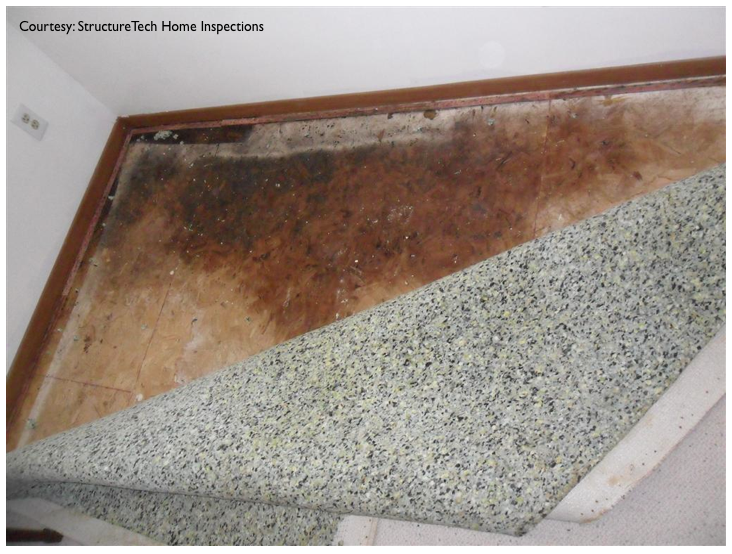
Roof leak minneapolis, how to manage roof leak in Minnesota
Posted in Uncategorized
Ice Dam Prevention in Minneapolis and St. Paul
December 22nd, 2014
by Aaron Fruit
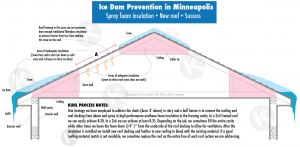
How to prevent ice dams
Ice dam prevention is a bit of a misnomer. Technically, it’s almost impossible to fully prevent ice dams if the conditions are right. Those conditions are: lots of snow, temperatures fluctuating between 10-20 degrees, inadequate insulation and ventilation and air leaks. Let’s not forget about air leaks.
We are in fact the only company in Minnesota that regularly tackles ice dam prevention from both the inside and the outside of homes. Kuhl Case Study #21 looks at a typical approach to solving ice dams on an Edina home from the inside. Simply put, that type of ice dam prevention project involves removing interior finishes (such as drywall or plaster), removing the insulation and replacing it with high R-value spray foam insulation from the inside. That work is finished with the installation of new drywall and repainting. One advantage to this approach to ice dam prevention in Minnesota is that it can be done year-round. Spray foam insulation in Minneapolis requires temperatures of at least 40 degrees to cure properly. Doing the work from the inside allows this to happen, even in the middle of winter.
There are other situations where it makes more sense to attack the ice dam problem from the outside of the home. Here is a list of conditions under which ice dam prevention is best addressed from the outside:
- The interior finishes are too expensive or complicated to remove and replace.
- Removal of the interior finishes will not allow for complete access to the problem areas.
- The client wants to avoid the mess and hassle of interior work.
- The roof system is in need of replacement (if the roof needs replacing anyway, it makes sense to add insulation from the outside because it is a more cost effective and less invasive approach to ice dam prevention).
- The roof system needs major modifications to the ventilation components (soffit vents, clogged air chutes and box vents can not be addressed from the inside of the home).
Some homes with ice dams in Minneapolis have terrible insulation from top to bottom while others only have a few ‘weak’ spots. Still, even a couple of weak areas can have catastrophic effects in the form of big, bad ice dams. If you study the ice dam prevention diagram above you will see that on some roofs, the weak spot happens in the middle of the roof. The area below the knee wall often has plenty of space for insulation and ventilation, as does the area above the collar ties. Incidentally, the collar ties are the framing members the define the ceiling of the standard story and a half ceiling. The problem area occurs in the area between knee walls and the collar ties, where there is only either 2×4 or 2×6 roof framing to accommodate the insulation system. Given that almost all homes with this sort of roof framing are were built before 1960, the insulation installed in those roofs is likely either rock wool or standard fiberglass batts. The net result is very little R-value standing between the cozy interior and the frigid exterior. That’s where high-performance spray foam comes into play. We can pack in 2-3 times the R-value in the same space using spray foam instead of fiberglass. Plus, spray foam acts as an air sealer as well, keeping dreaded hot air leaks from reaching and heating the roof deck. Here are some photos of a recent project we completed in Minneapolis using spray foam insulation to address chronic ice dams.

Ice dam prevention in Edina home. Ice Dam Prevention Minneapolis
The first step in the process to prevent ice dams (or greatly reduce the likelihood they will occur) is to peel back the roofing over the area between the knee wall and the collar ties. This exposes the fiberglass insulation, which can then easily be removed. This photo also demonstrates another very common issue; lack of ventilation. You can see that there is no room above the fiberglass batts to allow air to flow from the soffits to the box vents on the top side of the system. When we install spray foam in cavities like this, we often leave about a 3/4″ to allow for ventilation. The exception to this rule is when we create what is called a ‘hot roof’. That topic will be covered in a future blog.

Ice dam prevention in Edina home. Ice Dam Prevention Minneapolis
The next step in the ice dam prevention process is to strip spray in high performance closed cell urethane insulation. The key here is to spray on top of the existing knee wall and collar tie lines. Again, it often makes sense to leave a small air-space on top of the new foam insulation to enable a ventilation pathway from the soffits up through the ridge of the roof.
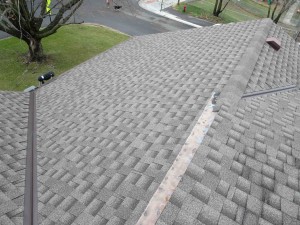
Ice dam prevention in Edina home. Ice Dam Prevention Minneapolis
The final step in this approach to ice dam prevention via spray foam insulation is the most simple. Find the matching roof material and install it professionally. Can you see the lines between old and new? When matching materials are not available the only option is to replace the enter affected roof pitch. One advantage to this approach is that we are able to install more ice and water membrane that what was originally installed (usually just enough to meet building code and nothing more).
When it comes to preventing ice dams in Minnesota, no one does more of this sort of work that we do. It takes a bit of forensic analysis up front to figure out the best solution to the problem. In some cases, such as the Edina home shown here, the best solution to solving ice dams is to remove the roofing and address the issue from above.
Posted in Uncategorized
Minneapolis ice dam prevention
December 18th, 2014
by Aaron Fruit
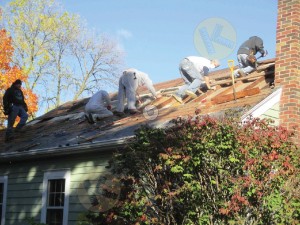
Ice dam prevention contractor in Minneapolis
The best solution to ice dams in Minnesota is holistic. Because ice dams in Minneapolis are the result of a complex interaction among many variables, including insulation, ventilation, roofing, home architecture, climate and homeowner lifestyle, the answer to each ice dam problem is always unique to the case. Some ice dam prevention is as simple as adding insulation, or heat cables. But simplicity in the ice dam prevention world is the exception, not the rule. More often we have to employ a multifaceted approach. In this case, our client suffered through year after year of ice dams, despite having hired an insulation contractor on two separate occasions to ‘fix’ the problem. Our answer was to remove the asphalt shingles from the problematic roof pitch and insulate from above using high-performance spray foam to address the ice dam problem. When we tear off the roof and the roof deck we are able to see and address every possible variable that is creating the problem. From sealing all air leaks to adding ventilation in tight soffits to applying spray foam to the areas too tight to benefit from traditional fiberglass insulation, ice dam prevention in Minneapolis is best handled from above. After all of the underlying causes of the ice dam problems have been resolved, we install new roof decking and follow it up with the highest quality ice and water membrane sold. Ice and water membrane is a code-required, sticky material applied in rolls to the lower eave areas to help prevent water intrusion as the result of ice dams. Notice that I said ‘help prevent’ and not ‘prevent’ alone. Ice and water membrane manufactures will not publicly admit this but their products don’t prevent water intrusion from ice dams. They slow it down at best. That said, it’s a smart idea–and a code requirement–to install this membrane on the lower eave areas (and a few others) during the re-roof process.
We offer a unique perspective on ice dam prevention in Minneapolis. There are plenty of companies that remove ice dams, including our sister company (www.icedamcompany.com). There are insulation companies, roofing companies, electricians who wire heat cable systems and so on. We are the only company that does all of the above under one roof (pun intended). I published an article in the Journal of Light Construction on ice dams a couple of years ago. Here it is if you would like to geek out on that topic. Note: The diagram below shows one of many approaches to addressing ice dams. It does not detail many of the other variables that would need to be addressed, such as the insulation and air-sealing of the knee wall to floor intersection or the insulation and ventilation of the roof framing above the area detailed in the illustration. Again, ice dam prevention is seldom as simple as applying a single fix. It’s normally about using a number of solutions at once.
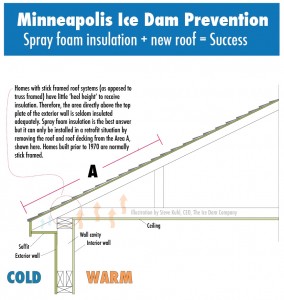
Ice dam prevention using insulation contractor Kuhl’s Contracting Minneapolis
Posted in Uncategorized
Chimney leaks in Minneapolis; Part One
December 18th, 2014
by Aaron Fruit
Chimney leaks in Minneapolis are very, very common. Unlike many areas of the country we deal with the affects of ice and snow, in addition to the normal forces that affect chimney performance such as wind, rain and the sun. I will be writing a few posts about common chimney damage in the coming weeks. This post focuses on the top of the chimney, otherwise known as the ‘wash cap’.
Below are two Kuhl drawings, one showing a poor, albeit super common chimney cap design in Minneapolis, the other, the proper design.
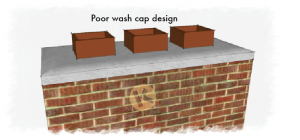
Kuhls Contracting Minneapolis Chimney Repair
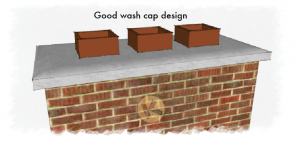
Minneapolis chimney repair Kuhl’s Contracting Edina masonry
The same process that creates potholes on our Minnesota roads is acting on your masonry chimney. It’s true and the principle is quite simple. See my little diagram, right.
The easiest way to keep your brick or stone chimney in good condition is to keep water from working its’ way into the cracks that inevitably develop on the surface of your chimney. The majority of the chimneys I inspect that have damage have one major flaw in common. They lack an overhang to encourage water to say away from the column of the chimney. Just as homes typically have overhangs at the eaves so should chimneys.
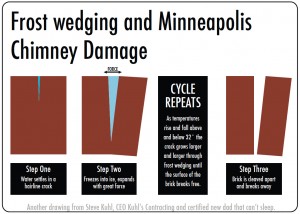
Chimney repair cost in Minneapolis. Average price for chimney repairs in Minneapolis.
Most of the masonry and stone chimneys we repair in the Minneapolis area receive a new wash cap, some brick resetting and general tuck pointing. Some chimneys have to be completely rebuilt. The main determining factor in how much damage we find is how long the homeowner has let water do its’ thing through the freeze-thaw cycle on their chimney.
Here is an example of a very common problem we find on Minneapolis chimneys. The masons who built the original chimney used mortar, not concrete, to hand-trowel the wash cap into shape. It lacks any overhang and has allowed water to find its’ way into the body of the chimney column over time. Through the freeze-thaw cycle that water has caused severe damage to the material below the cap. We replace about 150 bad wash caps a year for this very reason.
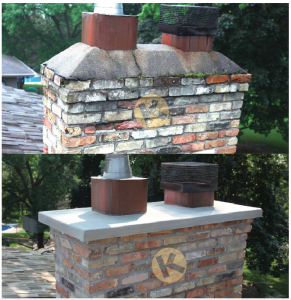
Kuhl’s Contracting: Best Minneapolis chimney repair
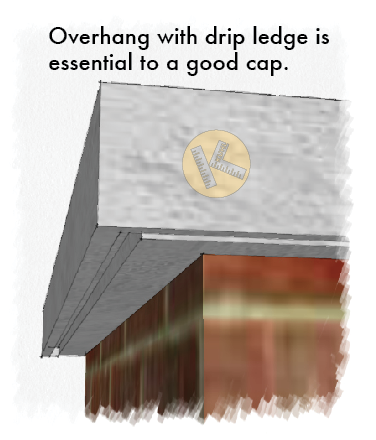
Who to call to fix a chimney in Minneapolis
Posted in Uncategorized























